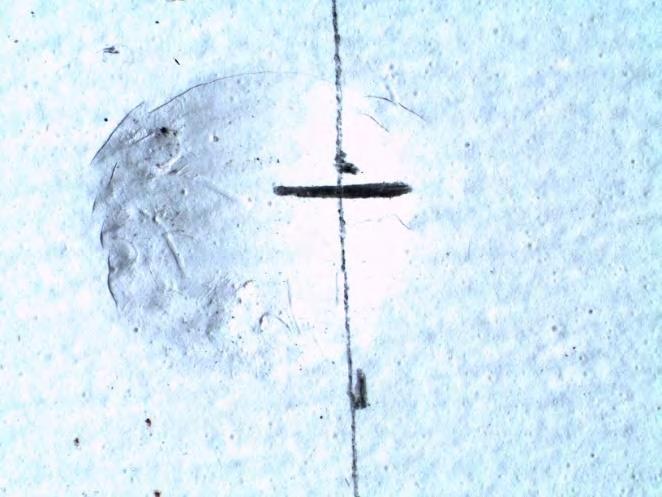
25 minute read
SURFACE FINISH QUALITY OF WOOD
ACTA FACULTATIS XYLOLOGIAE ZVOLEN, 62(2): 61−74, 2020 Zvolen, Technická univerzita vo Zvolene DOI: 10.17423/afx.2020.62.2.06
INTERLAYER WITH MICROCAPSULES AND ITS INFLUENCE ON THE SURFACE FINISH QUALITY OF WOOD
Advertisement
Gabriela Slabejová Mária Šmidriaková Ján Svocák
ABSTRACT
The paper deals with the quality of standard and modified surface finishes on beech, oak and spruce wood intended into exterior. Modified surface finish was created by the same coating materials as a standard surface finish, but it contained an interlayer with microcapsules. The quality of the surface finishes was assessed according to the film hardness, impact resistance, the resistance to scuffing, adhesion tests, the Cross-cut test and the Pull-off test for adhesion. The interlayer with microcapsules had no impact on the surface hardness of the surface finishes on beech wood and spruce wood, but it positively affected the film hardness of oak wood. The modified surface finish on beech wood and spruce wood showed a low impact resistance at a low drop height. It was more fragile and the impact resistance test resulted in the cracks formation. The modified surface finish was more resistant to scuffing. The adhesion of the standard and modified surface finishes to individual tree species, tested according to the Cross-cut test, was the same or minimally different. According to the Pull-off test, the standard surface finish showed higher adhesion to beech wood and oak wood when compared with the modified surface finish. On spruce wood, the Pull-off test for adhesion determined cohesion of wood surface layers. Key words: adhesion, hardness, impact resistance, modified surface finish, resistance against scuffing
INTRODUCTION
The exterior pigmented surface finish is intended to protect wood, enhance the product aesthetically, and cover the substrate. Requirements for exterior wood finishing are put for the weather resistance mainly. In the world, the research is carried out using transparent and pigmented surface finishes. “To extend the lifetime of wood and maintain its natural look, the research and development of clear coatings with minimal use of harmful chemicals has become very important” (MIKLEČIĆ et al. 2017).
The resistance of the surface finish to weathering is not the only property that determines the quality. Many properties – visual, chemical, resistant, physical-mechanical –give information about how the surface finish will behave during the use. The important physical-mechanical property of the exterior surface finishes is the adhesion. In several works, the influences of type of surface finish, parts of wood, moisture, wood-destroying fungi, aging, and the surface pre-treatment on the adhesion were investigated (HAZIR and
KOC 2019, SLABEJOVÁ and VIDHOLDOVÁ 2019a, b, MIKLEČIĆ et al. 2017, VIDHOLDOVÁ et al. 2017, COOL and HERNÁNDEZ 2016, UGULINO and HERNÁNDEZ 2016, ŠOMŠÁK and
REINPRECHT, 2015, TOLVAJ et al. 2014, PODGORSKI et al. 2010, BULIAN and GRAYSTONE 2009,DELPECH and COUTINHO 2000,DE MEIJER and MILITZ 1998).
The surface finishes created by coating materials were evaluated according to appearance and physical-mechanical properties (HAZIR and KOC 2019, SLABEJOVÁ et al. 2019, SLABEJOVÁ et al. 2018, SLABEJOVÁ and ŠMIDRIAKOVÁ 2018, TESAŘOVÁ et al. 2017, SALCA et al. 2017, YONG et al. 2017, BEKHTA et al. 2014, MODRÁK and MANDULÁK 2013, SCRINZI et al. 2010).
To increase protection of wood and surface finish, the coatings can be adapted. The coatings can be modified with nano-technological products (CATALDI et al. 2017,MIKLEČIĆ et al. 2017, REINPRECHT and VIDHOLDOVÁ 2017, WETHTHIMUNI et al. 2016, KUMAR et al. 2015,KAYGIN and AKGUN 2009, LEE et al. 2003).
The presented work deals with pigmented surface finish intended to exterior. The surface finish contained a modifying interlayer with nano-technological product. The influence of the modifying intermediate layer on selected physical-mechanical properties of the surface finish was monitored.
MATERIALS AND METHODS
Test specimens
Beech wood (Fagus sylvatica L.), oak wood (Quercus petraea L.), and spruce wood (Picea abies /Karst./ L.) were used in the experiment. The dimensions of the test specimens were 250 mm × 80 mm × 20 mm, and the moisture content of 8 % ± 2 %.
The test specimens’surface was sanded according to the recommendations listed in technical sheets for the coating materials. The test specimens were surface finished on all sides by low-pressure spraying.
Coating materials
The following representative coating materials (ADLER) for pigmented surface finishinginto exteriorwere selected: Aquawood TIG HighRes Weiss – a base coat for wood, water-based protective impregnation with good covering ability; it is designed for a three-layer coating system with Aquawood Intercare SH and Aquawood – Spritzlack XT. Aquawood Intercare SH – water-based interlayer with low content of solvents, enriched with microcapsules for sealing of cracks caused by weathering. Aquawood Spritzlack XT – water-based pigmented finishing coat with excellent resistance to weathering.
Two types of surface finish were made: Standard surface finish – 1 coat with the Aquawood TIG HighRes Weiss (the average film thickness of 100 μm in wet condition) and 1 coat with the AquawoodSpritzlack XT (150-180 μm in wet condition). Modified surface finish – 1coat of the Aquawood TIG HighRes Weiss (100μmin wet condition), 1 coat of the modifying coating material AquawoodIntercare SH (150-180 μmin wet condition) and 1coat of the AquawoodSpritzlack XT (150-180 μm in wet condition).
Thickness of the coating film
Two methods were chosen to measure the film thickness: Destructive method – using the SuperPig SP 1100 instrument. Non-destructive method – using the ultrasonic instrument PosiTector 200.
Film hardness
The film hardness was determined by the Pencil test according to the standard STN EN ISO 15184 (2012). The results of the test were evaluated according to the pencil that scratched the surface (Table 1). The test started with the softest pencil – number 1.
Tab. 1 Degrees of film hardness.
Pencil number 1 2 3 4 5 6 7 8 9 10 11 12 13
Pencil hardness 3B 2B B HB F H 3H 4H 5H 6H 7H 8H 9H
Impact resistance
The impact resistance of the surface finishes was determined according to the standard STN EN ISO 6272-2 (2011). The intrusion (diameter of the intrusion) was measured and the surface finish was evaluated subjectively according to Table 2.
Tab. 2 Impact resistance: degree and evaluation.
Degree Visual evaluation
1 No visible changes 2 No cracks on the surface and the intrusion was only slightly visible 3 Visible light cracks on the surface, typically one to two circular cracks around the intrusion 4 Visible large cracks at the intrusion 5 Visible cracks were also off-site of intrusion, peeling of the coating
Surface resistance against scuffing
Evaluation of the surface finish resistance against scuffing was determined according to the standard STN EN ISO 7784-3 (2006). The coefficient of the resistance against scuffing KT was calculated according to the formula: KT = (m1 – m2)/F (1) Where: m1 – specimen weight before sanding (g), m2 – specimen weight after sanding (g), F – correction coefficient of the used pair of abrasive papers (F = 1,052). Sanding number ZT was calculated according to the formula: ZT = n * F (2) Where: n – the number of revolutions until the surface is sanded down to the surface, F – correction coefficient of the used abrasive papers (F= 1,052).
The surface sanding number ZT is determined when the tested surface finish is sanded down to the surface to at least 25 % of the sanded surface.
Adhesion tests
Adhesion of the coating films to wood was determined by the Pull-off test according to the standard STN EN ISO 4624 (2016) and by theCross-cut test according to the standard STN EN ISO 2409 (2013).
The testing machine PosiTest AT-M (Qualitest, Canada) was used for the Pull-off test. Small 20 mm diameter dollies were glued to the coating using two-component epoxy resin (Pattex Repair Epoxy). After 24 h of curing at 20 °C and a relative air humidity of 60%, perimeters of glued dollies were carefully incised to prevent propagation of failures outside the tested area. Pulling was carried at a rate of 1 mm/min up to separation of the dolly from the surface. After each test, the fracture was evaluated visually using a stereo-microscope LEICA MZ 9.5 with magnification of 4 ×.
The Cross-cut test was done as follows: a cross hatch pattern was cut through the coating film to the substrate. The adhesion of the coating film was classified according to the standard STN EN ISO 2409 (2013) (Table 3). The figures are examples for a cross-cut within each step of the classification. The percentages stated are based on the visual impression given by the pictures and the same percentages will not necessarily be reproduced with digital imaging.
Tab. 3 Evaluation of the cross-cut area.
Classification 0 1 2 3 4 5
Surface of crosscut area from which flaking has occurred. (Example for six parallel cuts) none < 5% 5% – 15% 15% – 35% 35% – 65% > 65%
RESULTS AND DISCUSSION
Thickness of coating film
The film thickness of surface finishes was determined by two methods (destructive, nondestructive, Table 4). The coating film thickness determined by the two different methods was similar. More significant difference was noticed only for the standard surface in the case of spruce wood (destructive method 138 μm; non-destructive method 108 μm). In all cases, the thickness of the coating film determined by the destructive method was slightly higher than the thickness determined by the non-destructive method. These slight differences may be due to the fact that if measured by the destructive method, the part of the film impregnating the surface layer of wood is included in the thickness of the coating film. In the ultrasonic non-destructive method, these surface layers are probably not counted to the film thickness, but are considered as a substrate. Particularly onthe spruce wood, the wood surface layer could be impregnated deeper (from a microscopic point of view).
Knowing the thickness of the coating film is not only needed to determine the adhesion by the Cross-cut test, but the thickness also affects quality of the surface finish. HUNDHAUSEN et al. (2018) and PALIJA et al. (2018) focused on factors that affect the thickness of a coating film in industrial production; because the effect of thickness on quality is significant.
Tab. 4 Coating films thickness.
Coating film thickness [μm] Sample Beech – 2 Beech – 3 Oak – 2 Oak – 3 Spruce – 2 Spruce – 3
Destructive 166 256 140 270 138 218 Non- destructive 158 237 129 251 108 206
Film hardness
The surface hardness of the coating film is a degree, which corresponds with the pencil which damaged the surface as the first (Table 5). Both types of surface finish in the case of spruce wood and beech wood showed the film hardness of 6. On oak wood, the standard surface finish reached the hardness of 8 and the modified surface finish the hardness of 9. The results show that higher surface hardness could be reached by a harder substrate, a slightly thicker coating film, or by the interaction of the two factors. The highest hardness of the coating
film was achieved by the modified surface finishes on oak wood (Table 5). From comparison of the two types of surface finish in the case of spruce wood and beech wood, we can conclude that the surface hardness was not affected by the interlayer. The results in this work are similar to the statements by HAZIR andKOC (2019)that higher surface hardness may not provide higher impact resistance, but a harder surface may be more fragile.
Tab. 5 Surface hardness of coating films. Degree of film hardness Sample Beech– 2 Beech– 3 Oak– 2 Oak– 3 Spruce – 2 Spruce– 3
Pencil number 6 6 8 9 6 6
Impact resistance of surface finish
The impact resistance, (the diameter of the intrusion) was measured and the damage on the surface finish was evaluated subjectively according to Table 6. The modification of surface finish did not increase the impact resistance if compared to the standard surface finish. On spruce wood, the modified surface finish showed low impact resistance even at a drop height of 50 mm. At this drop height, a semi-circular crack was formed around the intrusionin the surface finish. This was also observed on beech wood at drop heights of 100 mm and 200 mm, and on oak wood at a drop height of 200 mm. We can conclude that the modified surface finishis less resistant than the standard surface finish. It is more fragile and therefore cracks appear on it sooner.
However, the total damage of both types of surface finish was greater in the case of spruce wood than on beech wood or oak wood. The lowest impact resistance (grade 5) was measured for both types of surface finish in the case of spruce wood at the maximum drop height of 400 mm (Fig. 1). In this case, the cracks were formed in the surface finish outside the intrusion. This finding shows that the modified surface finish may be more prone to cracking when hailing or during mechanical damage caused by little rocks. The purpose of the inter-layer is to seal the micro-cracks formed during aging of the surface finish in the exterior. But we found that the modified surface finish is more prone to cracking under mechanical loading.
Tab. 6 Degree of change on the surface and diameter of the intrusions.
Sample 10 Drop height [mm] 25 50 and Degree of change 100 200 400
BEECH - 2 1 1 2 2 2 3 Ø mm 0 1 3 4 4 5 BEECH - 3 1 2 2 3 3 3 Ø mm 0 2 2 4 4 5 OAK - 2 1 2 2 2 2 3 Ø mm 0 2 3 4 5 5 OAK - 3 1 1 2 2 3 3 Ø mm 0 1 2 4 4.5 5 SPRUCE - 2 1 2 2 3 3 5 Ø mm 0 1 3 4 5 5.5 SPRUCE - 3 1 2 3 3 4 5 Ø mm 0 2 4 4.5 5 6
Impact resistance of the coating increases with increasing thickness of the coating to some extent (SLABEJOVÁ 2012, SLABEJOVÁ et al. 2018). In our case, the coating film of the modified surface finish had higher thickness than the standard surface finish and this fact also confirms the above mentioned statement. HAZIR and KOC (2019) claim that the impact
resistance of the surface finish is significantly influenced by the type of surface finish. That means it is influenced by all the components present in the coating film. This was also confirmed by our results; the modifying interlayer had an effect on the impact resistance of surface finish at some drop heights.
Standard Modified
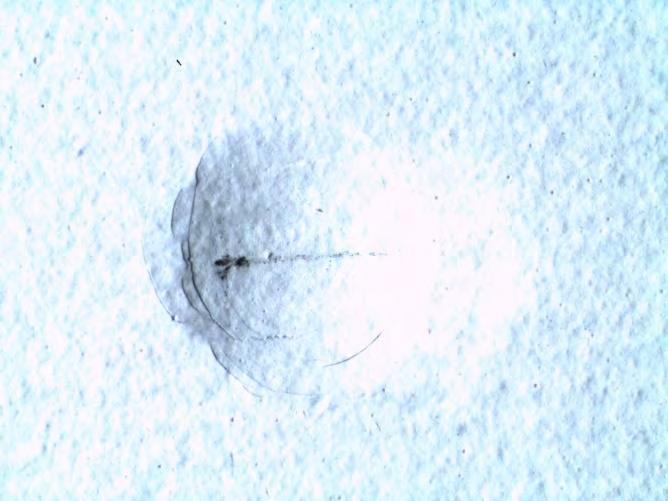
Beech
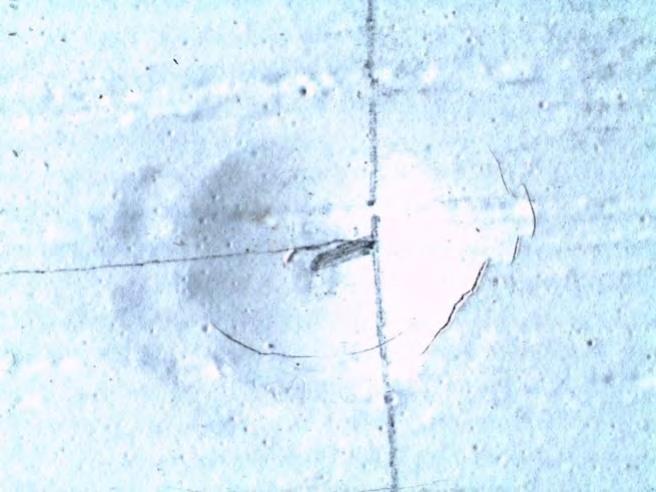
Standard Modified
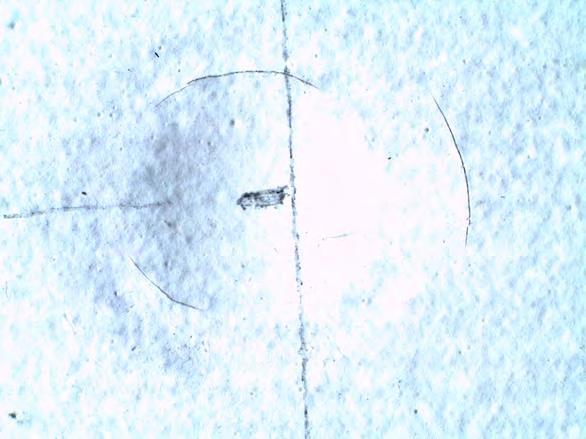
Oak
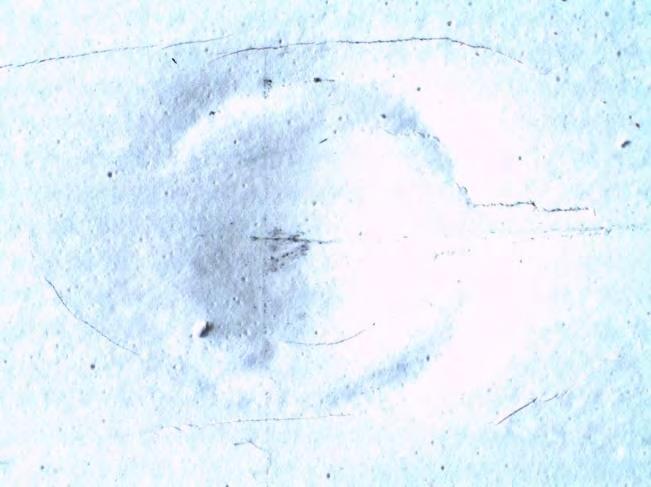
Standard Modified
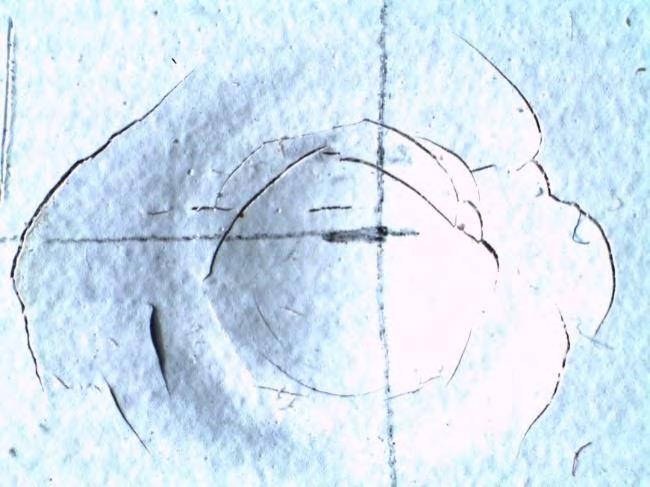
Spruce Fig. 1 Surface finishes after impact resistance test at a drop height of 400 mm; evaluated visually using a stereomicroscope (with magnification of 4 ×).
Surface finish resistance against scuffing
When evaluating the resistance against scuffing, the modified surface finish showed higher resistance than the standard surface finish on all three tree species. The coefficient of the coating film resistance against scuffing KT for the modified surface finish was smaller than the one for the standard surface finish (Table 7).
Tab. 7 The coefficient of resistance against scuffing KT and sanding number ZT.
Surfac efinish resistance agains scuffing Sample Beech – 2 Beech – 3 Oak – 2 Oak – 3 Spruce – 2 Spruce – 3 KT 0.057 0.038 0.057 0.038 0.066 0.019
ZT
841.6 1578 736.4 1683.2 946.8 1472.8
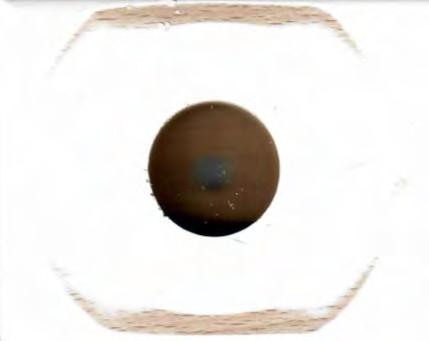
Standard Modified

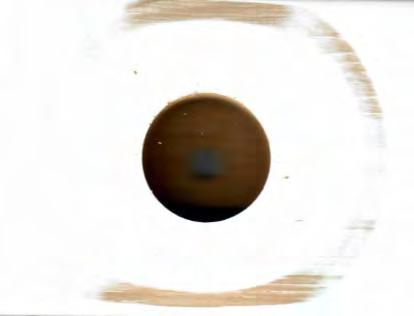
Standard
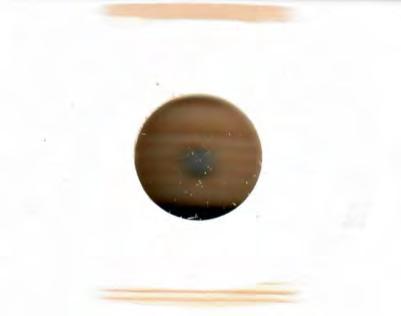
Standard Beech
Oak Modified
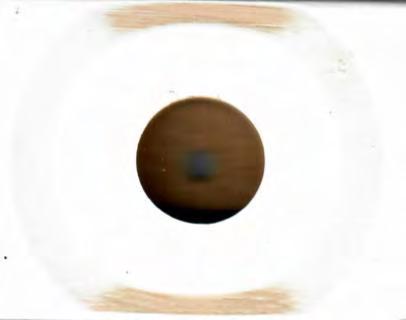
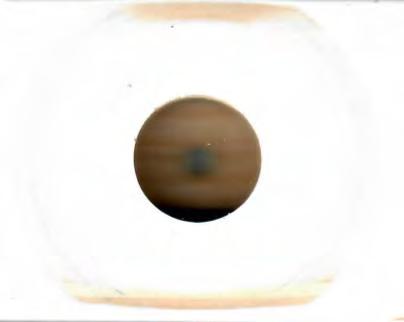
Modified
Spruce Fig. 2 Scans of the surface finishes after resistance to scuffing test.
The higher resistance against scuffing was also confirmed by the other coefficient, the sanding number ZT (Table 7). For the standard surface finish, at least 25 % sanding to the substrate (Fig. 2) occurred after only 700 revolutions on oak wood, after 800 revolutions on beech wood, and after 900 revolutions on spruce wood. For the modified surface finish, at
least 25% sanding to the substrate (Fig. 2) occurred after 1600 revolutions on oak wood, after 1500 revolutions on beech wood, and after 1400 revolutions on spruce wood.
Adhesion of the coating film according to the Cross-cut test
The adhesion determined by the Cross cut test was evaluated according to Table 8. The adhesion of both the modified and standard surface finishes to oak wood and spruce wood was of grade 2. The adhesion of modified surface finish to beech wood was of grade 2 and the adhesion of standard surface finish of grade 1. It can be stated that the adhesion of the standard and modified surface finish to the individual wood surfaces was the same or slightly different (Fig. 3).
Tab. 8 Degree of damage at Cross-cut testing. Beech-2 Beech-3 Oak-2 Oak-3 Spruce-2 Spruce-3
Classification 1 2 2 2 2 2
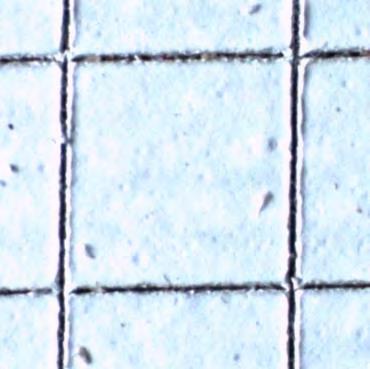
Standard Modified
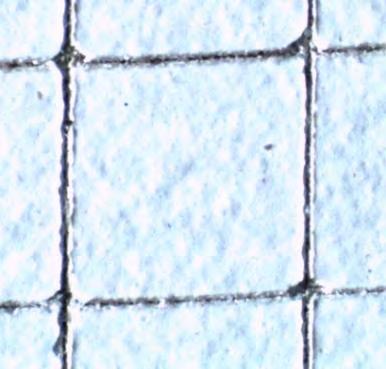
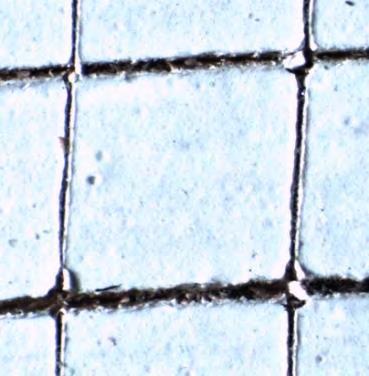
Standard
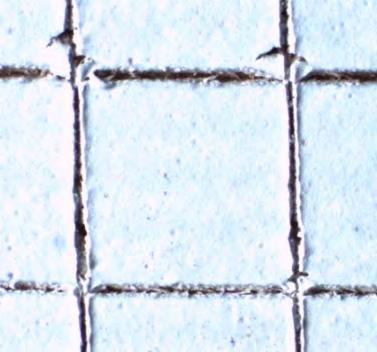
Standard Beech
Oak Modified
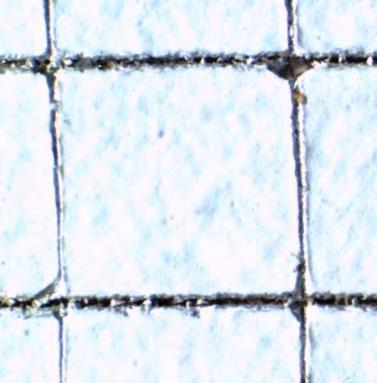
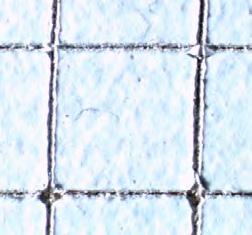
Modified
Spruce Fig. 3 Surface finishes after the Cross-cut test evaluated visually using a stereomicroscope (with magnification of 4 ×).
Adhesion of the coating film according to the Pull-off test
Statistical evaluation of adhesion is given in Table 9. The results of the two-factor analysis showed that the adhesion of coating film was statistically significantly influenced by the tree species. Also the type of surface finish and the interaction ”tree species – type of surface finish“ showed a high significant impact on the adhesion of the coating film.
Tab. 9 Basic table of analysis of variance for specific adhesion.
Sum of squares Degree of freedom Variance F – test p – significance level F - test
Abs. member 2900.808 1 2900.808 8239.296 0.0000000000000 Tree species 84.427 2 42.214 119.901 0.0000000000000 Type of surface finish 25.193 1 25.193 71.557 0.0000000000040
Interaction “tree species – type of surface finish”
24.165 2 12.083 34.319 0.0000000000606 Error 23.237 66 0.352
Fig. 4 shows that the standard surface finish if compared with the modified surface finish reached higher adhesion to both beech wood and oak wood. On spruce wood, there was no difference in the adhesion between the standard and modified surface finishes. The modified surface finish in the case of spruce wood had a higher variance of values of adhesion.

Fig. 4 Surface finishes' adhesion to individual tree species.
The fracture in the system “wood – coating film – metal dolly“ was evaluated visually using a microscope at 4 × magnification. Fig. 6 a), c) and e) show the fracture on the standard surface finish after separation of the dolly. The figures show the surfaces of the metal dollies with the coating film separated from beech, oak, and spruce wood. On the surface of the dolly, areas of the coating film with separated wood fibres can be seen by a microscope. On beech wood and oak wood, separation of wood fibres was minimal and the separated wood fibres did not exceed 10 % of the area under the dolly. On the contrary, on spruce wood, separation of wood fibres was the most significant and, in some cases, reached more than 45 % of the area under the dolly.
Fig. 5 a) to f) show wood surfaces after separation of the dollies. The separated wood fibres are visible. On beech wood and oak wood, after separation of the dolly, the fracture occurred at the interface “wood – coatingfilm”. The fibres were separated to a small extent, up to 10 % only. Such type of fracture confirms that the measured value of adhesion is the adhesion of coating film to wood surface. On spruce wood, the separation of the surface layers of wood occurred in larger extent. This type of fracture can be considered a cohesive fracture in the surface layers of wood.
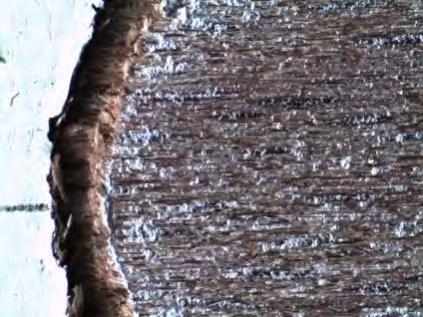
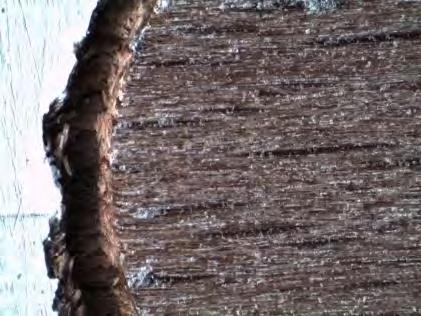
Surface of wood Dolly Surface of wood Dolly a) Standard b) Modified Beech
Surface of wood Dolly Surface of wood Dolly c) Standard d) Modified Oak
Surface of wood Dolly Surface of wood Dolly e) Standard f) Modified Spruce Fig. 5 Surface finishes after the Pull-off test; evaluated visually using a stereomicroscope (with magnification of 4 ×).
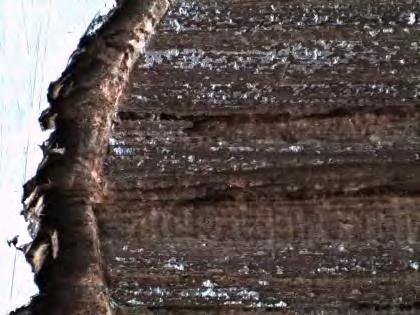
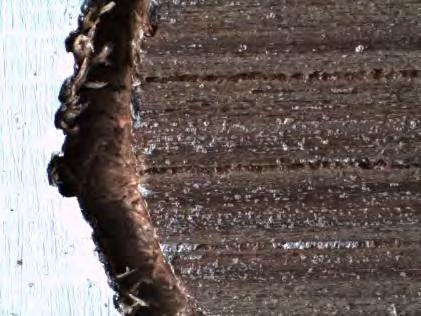
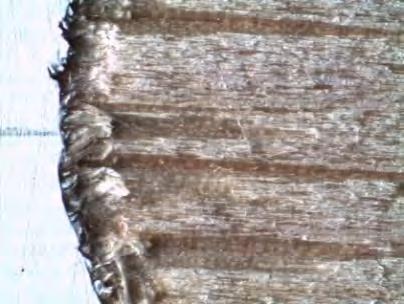
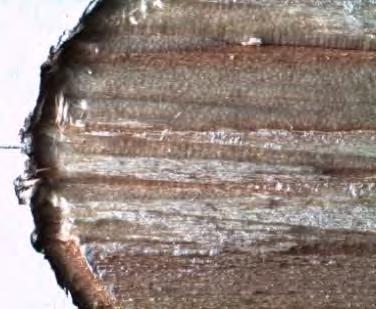
The adhesion of the coating film of the modified surface finish to beech wood and to oak wood was lower if compared with the standard surface finish. The modifying intermediate layer showed a negative effect on the adhesion of coating film to the substrate. Fig. 5 b) and d) show that after the dolly was separated, there was little separation of the surface wood fibres. The fracture can be described as an adhesion fracture. At these two tree species, the amount of separated wood fibres did not exceed 10 % of the area under the dolly. Fig. 5 b) and d) show that after the dolly was separated almost no coating film remained on the wood surface. As with the standard surface finish, so the modified surface finish, the largest amount of fibres were separated from spruce wood (more than 45 % of the area under
the dolly; Fig. 5 f). Again, it can be stated that, on spruce wood, the fracture can be considered as a cohesive fracture in the surface layers of wood. Fig. 4 show that the adhesion of the standard surface finish and the modified surface finish to beech wood and oak wood was different. On spruce wood, the difference was not registered because the fracture occurred in the surface layers of wood; so the measured values were similar.
The high significant impact of surface finish on the adhesion was also confirmed by HAZIR andKOC (2019), SLABEJOVÁ and VIDHOLDOVÁ (2019b), MIKLEČIĆ, et al. (2017) and
DELPECH andCOUTINHO (2000).
According to the results by HAZIR and KOC (2019), a type of coating was an effective factor for the adhesion strength, surface coating hardness, layer thickness, and rapid deformation test.
Comparison of the two methods of the adhesion testing shows that the Cross-cut test has less informative value than the Pull-off test. According to the Cross-cut test, the modifying interlayer had no impact on the adhesion of coating film. From the results it is seen that the modifying layer reduced the adhesion of the coating film to hard tree species (oak, beech). Such a conclusion cannot be draw for the surface finish in the case of spruce wood because during the test, a failure occurred in the surface layers of wood, i.e. it was a cohesive fracture.
CONCLUSION
From the results of properties of the tested surface finishes, the following conclusions can be drawn: The surface hardness of the coating film was not affected by the modifying layer. The interlayer did not increase the surface hardness of surface finish. The surface hardness of the surface finish was influenced by tree species. Impact resistance of the surface finish, at a maximum drop height of 400 mm, was not affected by the modifying layer.At a drop height of 200 mm,the modified surface finish was less resistant and more fragile in comparison with the standard surface finish. The resistance against scuffing of the surface finish was increased by the modifying layer. The modifying layer in the surface finish had impact on the adhesion of the coating film. If compared the two surface finishes, the standard surface finish reached a statistically significantly higher adhesion to beech wood and to oak wood than the modified surface finish (evaluated according to the Cross-cut test).
REFERENCES
BEKHTA, P., PROSZYK, S., LIS, B., KRYSTOFIAK, T. 2014. Gloss of thermally densified alder (Alnus glutinosa Goertn.), beech (Fagus sylvatica L.), birch (Betula verrucosa Ehrh.), and pine (Pinus sylvestris L.) wood veneers. In European Journal of Wood and Wood Products 72(6), 799808. DOI: 10.1007/s00107-014-0843-3 BULIAN F., GRAYSTONE J.2009. Wood coatings: Theory and practice. Elsevier. 319 s. CATALDI,A,CORCIONE,C.E.,FRIGIONE,M.,PEGORETTI,A. 2017. Photocurable resin /nanocellulose composite coatings for wood protection. In Progress in Organic Coatings 106, 128136, DOI: 10.1016/j.porgcoat.2017.01.019 COOL, J., HERNÁNDEZ, R. E. 2016. Impact of three alternative surfacing processes on weathering performance of an exterior water-based coating. In Wood and Fiber Science, 48(1): 43–53.
DELPECH, M. C., COUTINHO, F. M. B. 2000. Water borne anionic polyurethanes and poly(urethaneurea)s: influence of the chain extender on mechanical and adhesive properties. In Polymer Testing, 19(8): 939–952. DE MEIJER, M., MILITZ, N. 1998. Wet adhesion measurements of wood coatings. In European Journal of Wood and Wood Products, 56(5): 306. HAZIR, E., KOC, K. H. 2019. Evaluation of wood surface coating performance using water based, solvent based and powder coating. In Maderas. Ciencia y tecnología, 21(4), ISSN 0718-221X [online] http://dx.doi.org/10.4067/S0718-221X2019005000404. HUNDHAUSEN, U., SLABOHM, M.,MEINLSCHMIDT, P. 2018. Industrial coating of wood cladding: In line control of board temperature, film thickness, and microfoam. Conference: PRA's 11th International WoodcaotingsCongressAt: Amsterdam. 10 s. KAYGIN,B.,AKGUN,E. 2009. A nano-technological product: An innovative varnish type for wooden surfaces. In Scientific Research and Essays, 4(1): 1–7. KUMAR, A., PETRIČ, M.,KRIČEJ, B., ŽIGON, J.,TYWONIAK, J., HAJEK, P., ŠKAPIN, A.S., PAVLIČ, M. 2015. Liquefied-wood-based polyurethane-nanosilica hybrid coatings and hydrophobization by selfassembled monolayers of orthotrichlorosilane (OTS). ACS Sustainable Chemistry and Engineering[ online] 3(10), 2533-2541. DOI: 10.1021/acssuschemeng.5b00723 LEE, S. S., KOO, J. H., LEE, S. S., CHAI, S. G., LIM, J. CH. 2003. Gloss reduction in low temperature curable hybrid powder coatings. In Progress in Organic Coatings [online] 46(4), 266-272. Online: http://thirdworld.nl/gloss-reduction-in-low-temperature-curable-hybrid-powder-coatings. MIKLEČIĆ, J., TURKULIN, H., JIROUŠ-RAJKOVIĆ, V. 2017. Weathering performance of surface of thermally modified wood finished with nanoparticles-modified waterborne polyacrylate coatings. In Applied Surface Science, 408: 103–109. MODRÁK, V., MANDULÁK, J. 2013. Exploration of Impact of Technological Parameters on Surface Gloss of Plastic Parts. Eighth CIRP Conference on Intelligent Computation in Manufacturing Engineering [online], 2013, 12: 504–509. [online] http://www.sciencedirect.com/science /article/pii/S2212827113007270. PALIJA, T., JAIĆ, M., DŽINČIĆ, I., ŠUĆUR, A., DOBIĆ, J. 2018. Variability of dry film thickness of a coating applied by roller coater on wood in a real industrial process. In Drewno, 61(201), 153–164. DOI: 10.12841/wood.1644-3985.251.13.
PODGORSKI,L.,GRÜLL,G.,TRUSKALLER,M.,JEAN-DENIS LANVIN,J.-D.,GEORGES,V.,BOLLMUS, S. 2010. Wet and dry adhesion of coatings on modified and unmodified wood: comparison of the cross-cut test and the pull-off test. IRG 41, Biarritz, France 913. máj 2010. REINPRECHT,L.,VIDHOLDOVÁ,Z. 2017. Growth inhibition of moulds on wood surfaces in presence of nano-zinc oxide and its combinations with polyacrylate and essential oils. In Wood research. 1, 37–43. ISSN 1336-4561. SALCA, E. A., KRYSTOFIAK, T., LIS, B. 2017. Evaluation of Selected Properties of AlderWood as Functions of Sanding and Coating. In COATINGS. ISSN 2079-6412. 2017, vol. 7, no. 10, art. no. 176. SCRINZI, E., ROSSI, S., DEFLORIAN, F., ZANELLA, C. 2011. Evaluation of aesthetic durability of waterborne polyurethane coatings applied on wood for interior applications. In Progress in Organic Coatings [online], 2011, 72(1–2): 81–87. [online] www.sciencedirect.com. SLABEJOVÁ, G., VIDHOLDOVÁ, Z. 2019a. Adhézia náterových filmov na poveternostne starnutom dreve. tzbinfo, Online: https://stavba.tzb-info.cz/drevostavby/19533-adhezia-naterovych-filmov-napoveternostne-starnutom-dreve SLABEJOVÁ, G., VIDHOLDOVÁ, Z. 2019b. Vplyv vybraných faktorov na adhéziu náterových filmov. In Dřevostavby. 5768. ISBN 978-80-86837-93-2 SLABEJOVÁ, G., ŠMIDRIAKOVÁ, M., KADLEČÍK, J.2019. Quality of surface finishes for beech stairs. In Annals of Warsaw University of Life Sciences. 67–71. ISSN 1898-5912 APVV-16-0177; VEGA 1/0822/17. SLABEJOVÁ, G., ŠMIDRIAKOVÁ, M., PÁNIS, D. 2018. Quality of silicone coating on the veneer surfaces. In BioResources, (13)1: 776−788. SLABEJOVÁ, G., ŠMIDRIAKOVÁ, M. 2018. Quality of pigmented gloss and matte surface finish. In Acta Facultatis Xylologiae Zvolen, 60(2): 105−113.
SLABEJOVÁ,G. 2012. Vplyv vybraných faktorov na stabilitu systému drevo – tuhý náterový film. In Acta Facultatis Xylologiae Zvolen, 54(2): 57–65. STN EN ISO 4624 (2016). Paints and varnishes. Pull-off test for adhesion. Slovak Office of Standards, Metrology and Testing, Bratislava, Slovakia. STN EN ISO 7784-3 (2016). Determination of paint resistance against scuffing by abrasive paper in "Taber-Abraser" apparatus. Slovak Office of Standards, Metrology and Testing, Bratislava, Slovakia. STN EN ISO 2409 (2013). Paints and varnishes. Cross-cut test. Slovak Office of Standards, Metrology and Testing, Bratislava, Slovakia. STN EN ISO 15184 (2012). Paints and varnishes. Determination of film hardness by pencil test. Slovak Office of Standards, Metrology and Testing, Bratislava, Slovakia. STN EN ISO 6272-2 (2011). Paints and varnishes - Rapid-deformation (impact resistance) tests - Part 2: Falling-weight test, small-area indenter. Slovak Office of Standards, Metrology and Testing, Bratislava, Slovakia. ŠOMŠÁK, M., REINPRECHT, L. (2015): Vplyv palzmy, fungicídov, UV-aditív a starnutia na adhéziu náterov k drevu. eConference of Doctoral Students and Young Researcher ISeC 2015 –Interdisiplinary Scientific eConference, 20-24 July 2015, NEXSYS, Ltd. Bratislava, 7 p. ISBN 97880-972051-0-2 TESAŘOVÁ, D., ČECH, P., HLAVATÝ, J. 2017. Influence of coating formulation on physicalmechanical properties. In Wood Science and Engineering in the Third Millenium: Proceedings of the International Conference (ICWSE 2017). Brasov: Universitatea Transilvania din Brasov, 486–493. ISSN 1843-2689. URL:http://www.unitbv.ro/il/Conferinte/ICWSE2017.aspx TOLVAJ,L.,MOLNAR,Z.,&MAGOSS,E.2014.Measurement of photo degradation-cause droughness of wood using a new optical method. In Journal of Photochemistry and Photobiology B: Biology, 134, 23–26. VIDHOLDOVÁ, Z., SLABEJOVÁ, G., KALOČ, J.2017. Influence of wood pre-weathering on selected surface properties of the system wood - coating film. In Acta Facultatis Xylologiae Zvolen, 2, 67–77. ISSN 1336-3824 UGULINO, B., HERNÁNDEZ, R.E. 2016. Analysis of sanding parameters on surfacproperties and coating performance of red oak wood. In Wood Material Science and Engineering, 1–9.
WETHTHIMUNI, M. L., CAPSONI, D., MALAGODI, M., MILANESE, C., LICCHELLI, M. 2016. Shellac/nanoparticles dispersions ad protective materials for wood. Applied Physics a-Materials Science&Processing 122(12), 1058. DOI: 10.1007/s00339-016-0577-7 YONG,Q.W.,NIAN,F.W.,LIAO,B.,GUO,Y.,HUANG,L.P.,WANG,L.,PANG,H. 2017. Synthesis and surface analysis of self-matte coating based on waterborne polyurethane resin and study on the matte mechanism. Polymer Bulletin 74(4), 1061-1076. DOI: 10.1007/s00289-016-1763-7
ACKNOWLEDGEMENTS
This work was supported by the Slovak Research and Development Agency under the contract No. APVV-16-0177.
AUTHORS’ ADDRESSES
Gabriela Slabejová Mária Šmidriaková Technical University in Zvolen Faculty of Wood Sciences and Technology T.G. Masaryka 24 960 01 Zvolen Slovakia slabejova@tuzvo.sk smidriakova@tuzvo.sk
Ján Svocák Technical University in Zvolen Faculty of Wood Sciences and Technology T.G. Masaryka 24 960 01 Zvolen Slovakia jsvocak@yahoo.com









